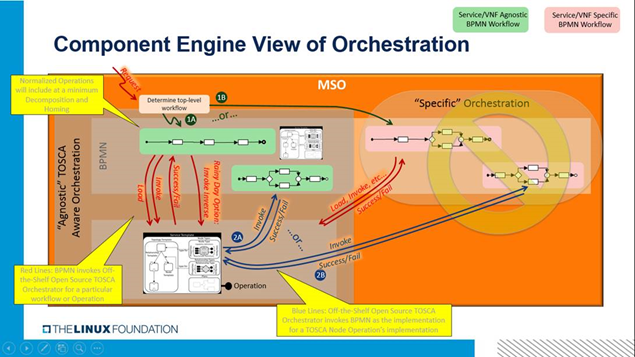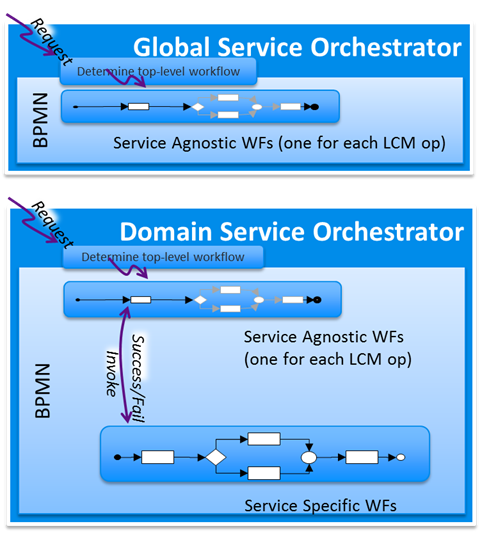Link to Project Proposal training materials
Project Name:
- Proposed name for the project: SO
- Proposed name for the repository:
so
Project description:
The SO provides the highest level of service orchestration in the ONAP architecture. Currently SO is implemented via BPMN flows that operate on Models distributed from SDC that describe the Services and associated VNFs and other Resource components. Cloud orchestration is currently based on HEAT templates.
In order to support Use Cases 1 and 2 in such a way to promote re-usability within ONAP, the goal of this project is to enhance ONAP’s overall orchestration capabilities by aligning and integrating its imperative workflows with a TOSCA-based declarative execution environment.
Service Orchestrator in ONAP WIKI
- This project proposes an expansion of ONAP SO to include a declarative topologically-driven approach to orchestration. Specifically this project proposes to enhance ONAP SO run-time orchestration framework to support orchestration driven from declarative models (TOSCA encoded) as well as integrated or independent BPMN imperative processing extensions that themselves could be TOSCA-aware.
This is envisioned as a multi-release project, which in its maturity will:
- Support TOSCA models in native format as distributed by SDC
- Perform lifecycle operations based on a declarative TOSCA model, including:
- Deployment
- Undeployment
- Scale (Out, In)
- Heal
- Software Upgrade (various forms)
Alternative 1: The following diagram illustrates one option for the internal processing BPMN and TOSCA Orchestrator sub-components within SO. In this approach a separate off-the-shelf TOSCA Orchestrator is incorporated into SO, with a top level BPMN layer delegating well defined orchestration activities to this native TOSCA Orchestrator (see diagram below).
Alternative 2: Another potential approach is shown below, where the BPMN itself in effect is a TOSCA Orchestrator component.
It is envisioned that initial Releases of this project would demonstrate both alternative approaches:
For Alternative 1 approach:
- Demonstrate SO BPMN workflows interacting with an off-the-shelf TOSCA Orchestrator to collectively drive orchestration behavior for at least an instantiation use case
- Demonstrate rainy day handling
- Accomplish the above in a way that is demonstrably extensible to support lifecycle operations such as Scale-In and Scale-Out.
For Alternative 2 approach:
- Demonstrate SO BPMN workflows to drive TOSCA-aware orchestration behavior for VoLTE use case, dependency to VF-C.
- Support lifecycle operations such as Scale-In and Scale-Out.
Architecture Alignment:
- How does this project fit into the rest of the ONAP Architecture?
What other ONAP projects does this project depend on?
SDC (true dependency with SDC SDK)
AAI (using API interface)
SDN-C (using API interface)
APP-C (no existing interface yet)
DMaaP (included as part of SDC SDK)
- MSB (no existing interface yet)
VF-C (no existing interface yet)
How does this align with external standards/specifications?
- TOSCA Simple Profile in YAML Version 1.0
- OASIS TOSCA Simple Profile for Network Functions Virtualization (NFV) Version 1.0
- Are there dependencies with other open source projects?
- ARIA
- JBOSS
- Camunda
- MariaDB
- EELF
- Resources:
- Primary Contact Person: DeWayne Filppi (dewayne@gigaspaces.com), Xin Jin (saw.jin@huawei.com OPEN-O R2 GS-O PTL), Steve Smokowski, ss835w@att.com (AT&T MSO PTL)
- Names, gerrit IDs, and company affiliations of the committers
- DeWayne Filppi, dewayne@gigaspaces.com GigaSpace
- Byung-Woo Jun - byung-woo.jun@ericsson.com Ericsson
- Xin Jin saw.jin@huawei.com Huawei
- Chuanyu Chen chenchuanyu@huawei.com Huawei
- Seshu Kumar, seshu.kumar.m@huawei.com Huawei
- Steve Smokowski, ss835w@att.com AT&T
- Rob Daugherty, rd472p@att.com AT&T
- John Choma, jc1348@att.com AT&T
- Gil Bullard, gil.bullard@att.com AT&T
- Ting Lu, tl2062@att.com AT&T
- Jeff Mitryk, jm5764@att.com AT&T
- Claude Noshpitz, cn5542@att.com AT&T
- Eric Debeau, eric.debeau@orange.com Orange
- Christian Destré, christian.destre@orange.com Orange
Eyal Holzman EyalH@Amdocs.com Amdocs
Barak Dabush Barak.Dabush@amdocs.com Amdocs
- Lingli Deng denglingli@chinamobile.com CMCC
- Chengli Wang wangchengli@chinamobile.com CMCC
- Anbing Zhang zhanganbing@chinamobile.com CMCC
- maopeng zhang zhang.maopeng1@zte.com.cn ZTE
- Joe Zhang, zhang.zhou1@zte.com.cn, ZTE
- Jinhua Fu fu.jinhua@zte.com.cn ZTE
- Jie Feng feng.jie2@zte.com.cn ZTE
- Li Jiang li.jiang@zte.com.cn ZTE
- Tian Yi tian.yi@zte.com.cn ZTE
- Hui Deng denghui12@huawei.com Huawei
- Thinh Nguyenphu, thinh.nguyenphu@nokia.com, Nokia
- Yan Yang yangyanyjy@chinamobile.com CMCC
- Ni Lu mail luna.lu@huawei.com Huawei
- Bin Hou mail bin.hou@huawei.com Huawei
- Hrvoje Kegalj hrvoje.kegalj@hr.ibm.com IBM
- Ethan Lynn ethanlynnl@vmware.com VMware
- Earle West ew8463@att.com AT&T
- Zhou Jun mail zhoujun8@huawei.com Huawei
- Liuhe Zhong zhognheliu@boco.com.cn
- Yuanwei Yang yangyuanwei@boco.com.cn
- Names and affiliations of any other contributors
- Project Roles (include RACI chart, if applicable)
Other Information:
- link to seed code (if applicable)
https://gerrit.onap.org/r/#/admin/projects/mso
https://gerrit.onap.org/r/#/admin/projects/mso/chef-repo
https://gerrit.onap.org/r/#/admin/projects/mso/docker-config
https://gerrit.onap.org/r/#/admin/projects/mso/libs
https://gerrit.onap.org/r/#/admin/projects/mso/mso-config
- Vendor Neutral
- if the proposal is coming from an existing proprietary codebase, have you ensured that all proprietary trademarks, logos, product names, etc., have been removed?
Subsequent modification to the existing seed code should continue to follow the same scanning and clean up principles. - Meets Board policy (including IPR)
Use the above information to create a key project facts section on your project page
Key Project Facts
Project Name:
- JIRA project name: Master Service Orchestrator (can be renamed as Service Orchestrator)
- JIRA project prefix: MSO- (can be renamed as SO-)
Repo name: mso (can be renamed as 'so' ?)
Lifecycle State:
Primary Contact:
Project Lead:
mailing list tag [Should match Jira Project Prefix]
Committers:
Rob Dugherty, rd472p@att.com, AT&T
John Choma, jc1348@att.com, AT&T
DeWayne Filppi dewayne@gigaspaces.com, GigaSpaces/Cloudify
Eyal Holzman EyalH@Amdocs.com
Barak Dabush Barak.Dabush@amdocs.com
Xin Jin saw.jin@huawei.com
Chuanyu Chen chenchuanyu@huawei.com
Seshu Kumar, seshu.kumar.m@huawei.com
Joe Zhang, zhang.zhou1@zte.com.cn, ZTE
liang wu wu.liang@zte.com.cn, ZTE
*Link to TSC approval:
Link to approval of additional submitters:


